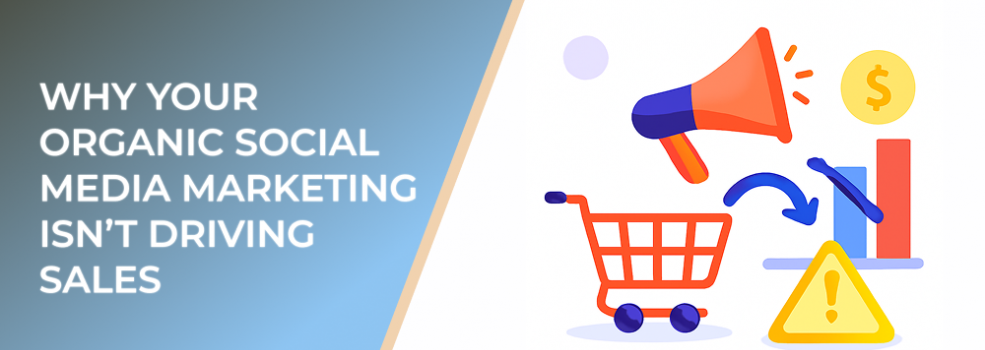Social media has become a central part of modern marketing strategies, and for good reason. With over 4.7 billion people using social media worldwide, the potential for brands to reach and engage their audience is vast. However, many businesses find that their organic social media efforts aren’t driving the sales they anticipated. Despite posting consistently, they may struggle to see a measurable return on investment. So, why isn’t your organic social media marketing translating into sales?
Let’s take a closer look at the potential reasons and how to address them.
1. Lack of a Clear Sales Funnel
While social media is an excellent tool for brand awareness and engagement, it won’t necessarily drive sales without a clear strategy. If your social media posts aren’t linked to a well-defined sales funnel, it can be hard for followers to move from engagement to actual purchasing decisions.
In fact, studies show that 60% of consumers are more likely to make a purchase after seeing a product or service on social media, but only 30% of brands actively drive followers to a sales page with clear calls to action. Without an optimized funnel guiding users toward conversion, your social media activity may simply be adding to your followers’ feeds, not their shopping carts.
What to do:
Make sure your social media strategy includes clear calls to action that direct users toward a purchasing decision. Whether it’s “Shop Now” or “Click to Learn More,” integrate these actions consistently. Use tools like Instagram’s Shopping feature or Facebook’s Marketplace to create seamless transitions from discovery to sale.
2. Inconsistent Posting and Messaging
Consistency is crucial when it comes to organic social media marketing. If you post sporadically or your content lacks a cohesive theme, your audience might become confused or disengaged. The algorithm also rewards consistency, meaning that businesses who post regularly tend to see better organic reach.
Research from HubSpot suggests that companies posting more than once a day see up to 30% more engagement compared to those posting once a week. However, it’s not just about quantity—it’s also about quality. If your posts aren’t resonating with your audience’s needs and interests, they won’t lead to sales.
What to do:
Create a content calendar to maintain regular posting and ensure your message is consistent. Focus on your audience’s pain points and interests to deliver value in every post. Don’t just post for the sake of posting; make sure each post has a clear purpose related to your sales strategy.
3. Neglecting Audience Engagement
Social media isn’t a one-way street. One of the main advantages of using social platforms is the ability to engage directly with your audience. But many businesses make the mistake of posting content without responding to comments, questions, or feedback. This can result in lost opportunities for building relationships and driving sales.
Statistics show that 56% of consumers will choose one brand over another based on its responsiveness on social media. If you aren’t engaging with your audience, you risk losing their attention, and ultimately, their business.
What to do:
Engage with your followers by responding to comments and messages promptly. Use interactive features like polls, quizzes, and questions to encourage participation. The more engaged your audience is, the more likely they are to trust your brand and convert into paying customers.
4. Relying Solely on Organic Reach
While organic content is essential, relying solely on it to drive sales can be limiting. Social media platforms like Instagram and Facebook have adjusted their algorithms in recent years, prioritizing paid content over organic posts. This means your content might not be reaching as many potential customers as it did in the past.
A report by Hootsuite found that only about 10% of your followers will see an organic post, with that number decreasing further if your engagement is low. Without paid support, your reach is restricted, and your sales potential could be capped.
What to do:
Consider combining your organic efforts with paid advertising. Even a small budget for targeted ads can significantly increase your visibility and drive more traffic to your site. Ads also allow for more granular targeting, ensuring that your content reaches the right people at the right time.
5. Not Analyzing and Optimizing Your Efforts
Social media marketing is not a set-it-and-forget-it strategy. Without analyzing the performance of your posts, it’s impossible to know what’s working and what’s not. Many businesses make the mistake of continuing to post without measuring engagement, clicks, or conversions.
Analytics tools from platforms like Facebook and Instagram can provide insights into what content resonates with your audience. By tracking these metrics, you can fine-tune your strategy for better results.
What to do:
Use platform analytics to track engagement and performance. Regularly analyze which types of posts get the most interactions and conversions, and adjust your strategy accordingly. Consider experimenting with different content formats—videos, carousels, and Stories—to see what drives the most engagement.
Final Thoughts
Organic social media marketing can be an invaluable tool for brand growth, but it’s not a quick fix for driving sales. To make your efforts pay off, ensure you have a well-defined sales funnel, post consistently with clear messaging, engage actively with your audience, and optimize your strategy using data. By aligning your social media efforts with your sales goals and adapting to platform changes, you can start turning likes and shares into actual revenue.

